Advanced Financial Accounting Report: CSR Limited, Impairment, Leasing
VerifiedAdded on 2020/05/28
|11
|2291
|27
Report
AI Summary
This report provides an in-depth analysis of advanced financial accounting, specifically focusing on asset impairment and lease accounting. The report examines the impairment of assets by CSR Limited, detailing the methodologies used, the subjectivity involved, and the impact on financial statements. It also explores the implications of the new lease accounting standards, contrasting the previous and current methods, and assessing the changes in financial reporting. The analysis covers the classification of leases, the impact on balance sheets, and the challenges faced by airline companies. The report discusses the criticisms of the new standards and the benefits of adopting the new accounting standards for leases, emphasizing improved transparency and more informed decision-making for investors. The report refers to relevant accounting standards and provides a detailed examination of the financial reporting practices.
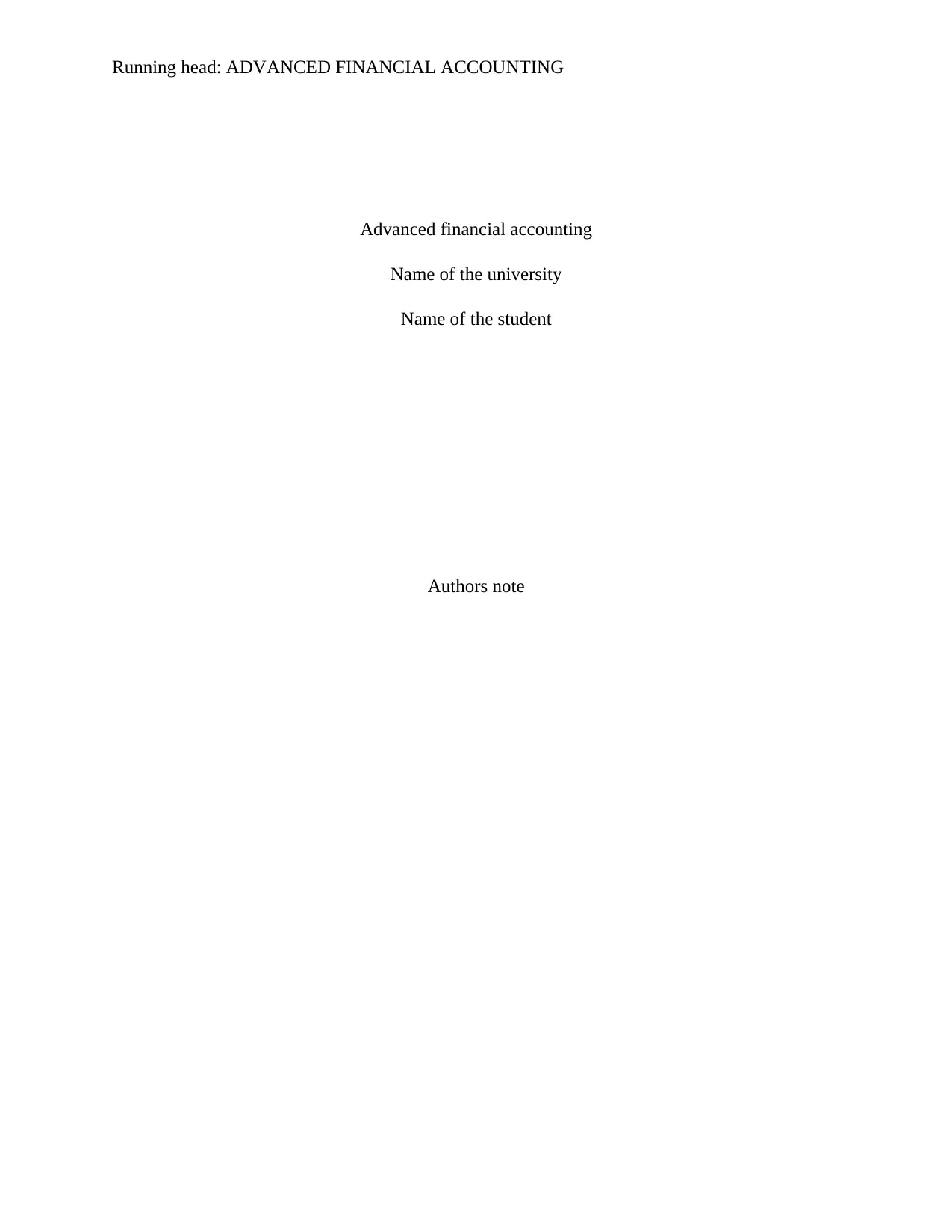
Running head: ADVANCED FINANCIAL ACCOUNTING
Advanced financial accounting
Name of the university
Name of the student
Authors note
Advanced financial accounting
Name of the university
Name of the student
Authors note
Paraphrase This Document
Need a fresh take? Get an instant paraphrase of this document with our AI Paraphraser
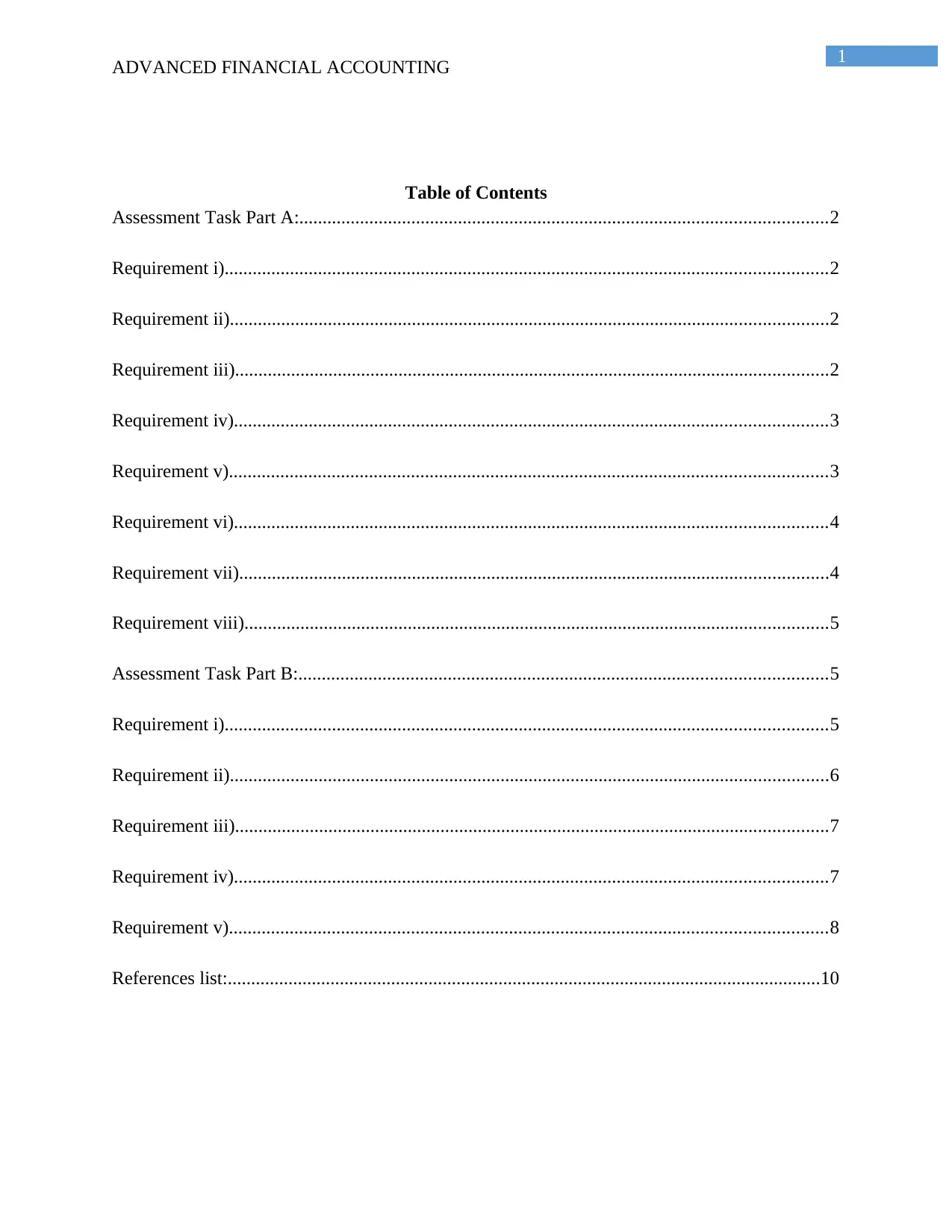
1
ADVANCED FINANCIAL ACCOUNTING
Table of Contents
Assessment Task Part A:.................................................................................................................2
Requirement i).................................................................................................................................2
Requirement ii)................................................................................................................................2
Requirement iii)...............................................................................................................................2
Requirement iv)...............................................................................................................................3
Requirement v)................................................................................................................................3
Requirement vi)...............................................................................................................................4
Requirement vii)..............................................................................................................................4
Requirement viii).............................................................................................................................5
Assessment Task Part B:.................................................................................................................5
Requirement i).................................................................................................................................5
Requirement ii)................................................................................................................................6
Requirement iii)...............................................................................................................................7
Requirement iv)...............................................................................................................................7
Requirement v)................................................................................................................................8
References list:...............................................................................................................................10
ADVANCED FINANCIAL ACCOUNTING
Table of Contents
Assessment Task Part A:.................................................................................................................2
Requirement i).................................................................................................................................2
Requirement ii)................................................................................................................................2
Requirement iii)...............................................................................................................................2
Requirement iv)...............................................................................................................................3
Requirement v)................................................................................................................................3
Requirement vi)...............................................................................................................................4
Requirement vii)..............................................................................................................................4
Requirement viii).............................................................................................................................5
Assessment Task Part B:.................................................................................................................5
Requirement i).................................................................................................................................5
Requirement ii)................................................................................................................................6
Requirement iii)...............................................................................................................................7
Requirement iv)...............................................................................................................................7
Requirement v)................................................................................................................................8
References list:...............................................................................................................................10
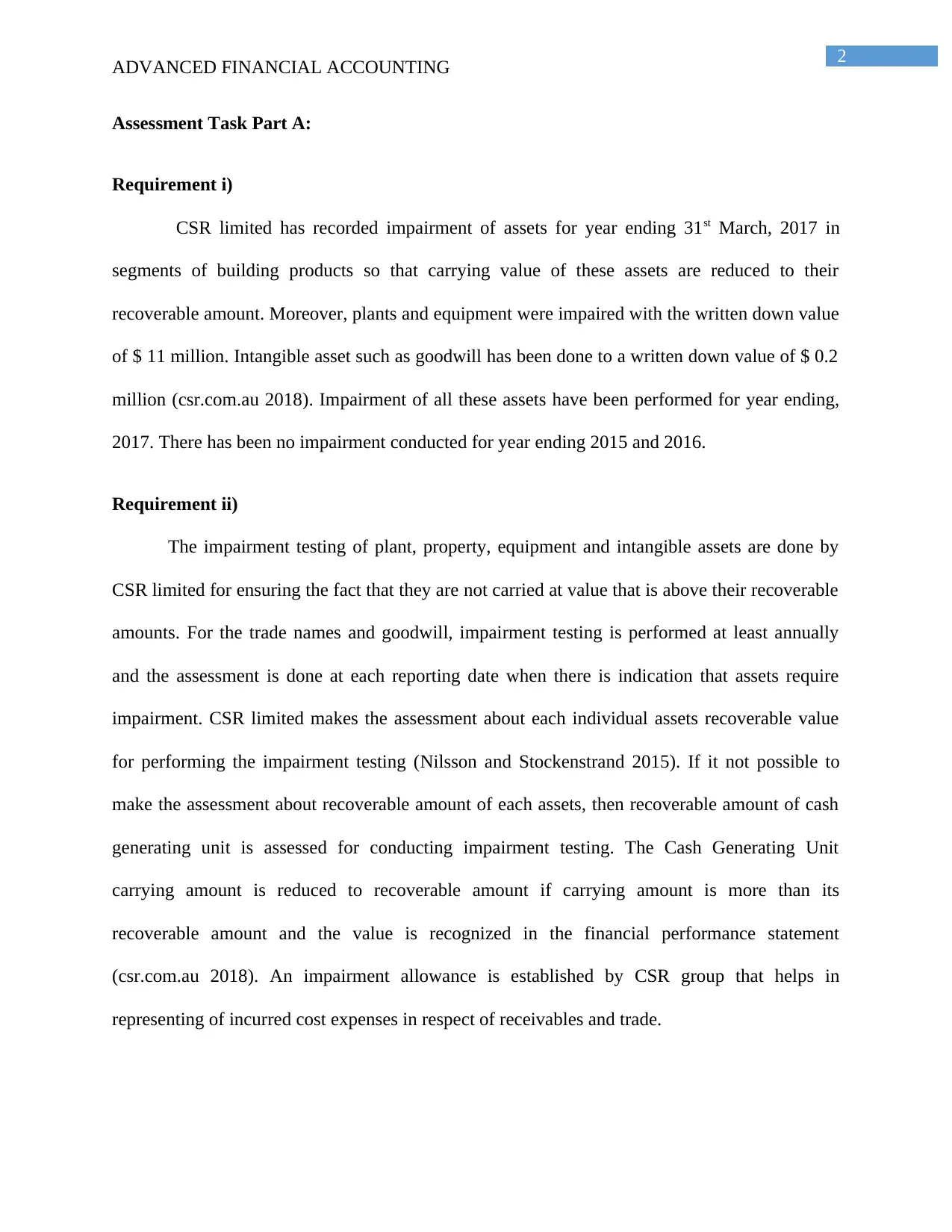
2
ADVANCED FINANCIAL ACCOUNTING
Assessment Task Part A:
Requirement i)
CSR limited has recorded impairment of assets for year ending 31st March, 2017 in
segments of building products so that carrying value of these assets are reduced to their
recoverable amount. Moreover, plants and equipment were impaired with the written down value
of $ 11 million. Intangible asset such as goodwill has been done to a written down value of $ 0.2
million (csr.com.au 2018). Impairment of all these assets have been performed for year ending,
2017. There has been no impairment conducted for year ending 2015 and 2016.
Requirement ii)
The impairment testing of plant, property, equipment and intangible assets are done by
CSR limited for ensuring the fact that they are not carried at value that is above their recoverable
amounts. For the trade names and goodwill, impairment testing is performed at least annually
and the assessment is done at each reporting date when there is indication that assets require
impairment. CSR limited makes the assessment about each individual assets recoverable value
for performing the impairment testing (Nilsson and Stockenstrand 2015). If it not possible to
make the assessment about recoverable amount of each assets, then recoverable amount of cash
generating unit is assessed for conducting impairment testing. The Cash Generating Unit
carrying amount is reduced to recoverable amount if carrying amount is more than its
recoverable amount and the value is recognized in the financial performance statement
(csr.com.au 2018). An impairment allowance is established by CSR group that helps in
representing of incurred cost expenses in respect of receivables and trade.
ADVANCED FINANCIAL ACCOUNTING
Assessment Task Part A:
Requirement i)
CSR limited has recorded impairment of assets for year ending 31st March, 2017 in
segments of building products so that carrying value of these assets are reduced to their
recoverable amount. Moreover, plants and equipment were impaired with the written down value
of $ 11 million. Intangible asset such as goodwill has been done to a written down value of $ 0.2
million (csr.com.au 2018). Impairment of all these assets have been performed for year ending,
2017. There has been no impairment conducted for year ending 2015 and 2016.
Requirement ii)
The impairment testing of plant, property, equipment and intangible assets are done by
CSR limited for ensuring the fact that they are not carried at value that is above their recoverable
amounts. For the trade names and goodwill, impairment testing is performed at least annually
and the assessment is done at each reporting date when there is indication that assets require
impairment. CSR limited makes the assessment about each individual assets recoverable value
for performing the impairment testing (Nilsson and Stockenstrand 2015). If it not possible to
make the assessment about recoverable amount of each assets, then recoverable amount of cash
generating unit is assessed for conducting impairment testing. The Cash Generating Unit
carrying amount is reduced to recoverable amount if carrying amount is more than its
recoverable amount and the value is recognized in the financial performance statement
(csr.com.au 2018). An impairment allowance is established by CSR group that helps in
representing of incurred cost expenses in respect of receivables and trade.
⊘ This is a preview!⊘
Do you want full access?
Subscribe today to unlock all pages.

Trusted by 1+ million students worldwide
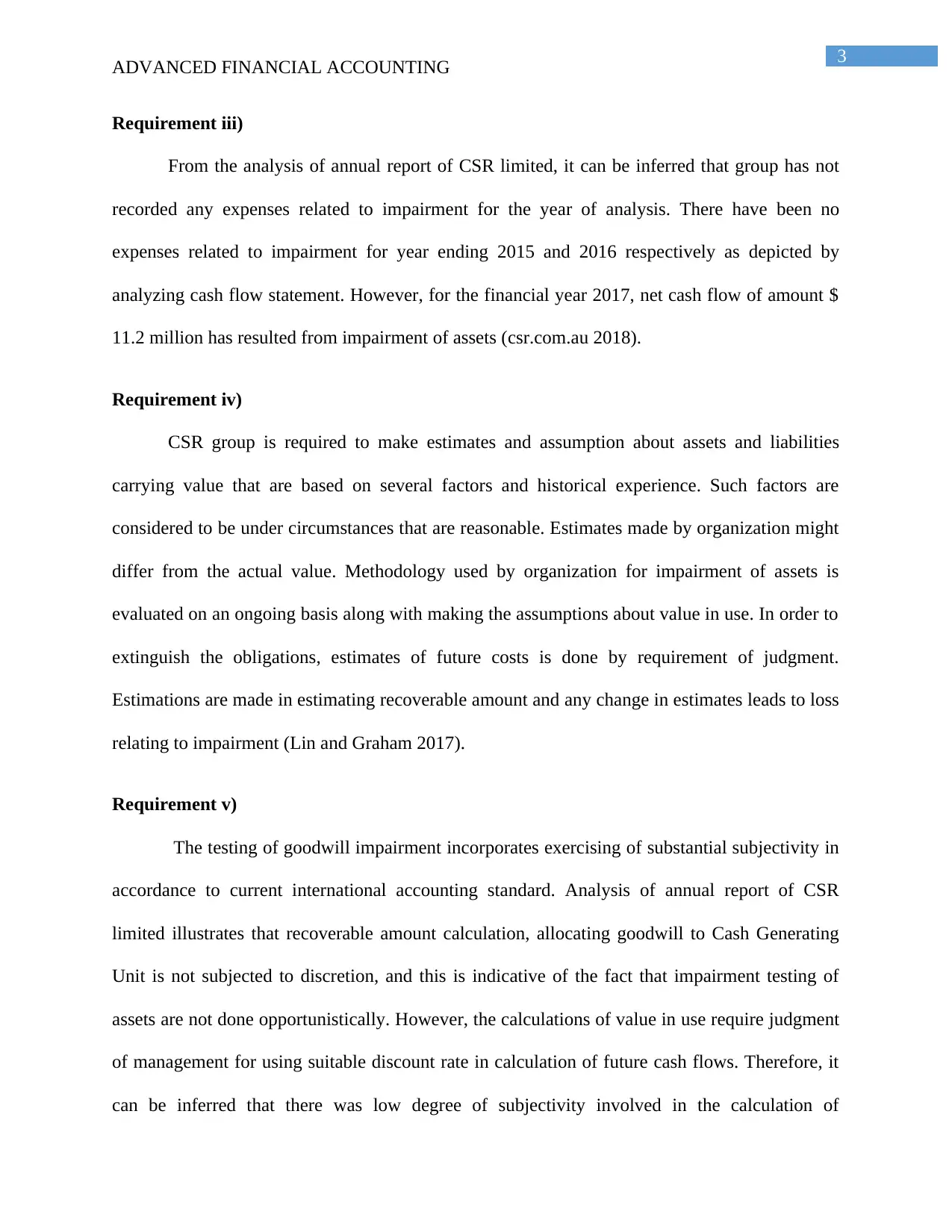
3
ADVANCED FINANCIAL ACCOUNTING
Requirement iii)
From the analysis of annual report of CSR limited, it can be inferred that group has not
recorded any expenses related to impairment for the year of analysis. There have been no
expenses related to impairment for year ending 2015 and 2016 respectively as depicted by
analyzing cash flow statement. However, for the financial year 2017, net cash flow of amount $
11.2 million has resulted from impairment of assets (csr.com.au 2018).
Requirement iv)
CSR group is required to make estimates and assumption about assets and liabilities
carrying value that are based on several factors and historical experience. Such factors are
considered to be under circumstances that are reasonable. Estimates made by organization might
differ from the actual value. Methodology used by organization for impairment of assets is
evaluated on an ongoing basis along with making the assumptions about value in use. In order to
extinguish the obligations, estimates of future costs is done by requirement of judgment.
Estimations are made in estimating recoverable amount and any change in estimates leads to loss
relating to impairment (Lin and Graham 2017).
Requirement v)
The testing of goodwill impairment incorporates exercising of substantial subjectivity in
accordance to current international accounting standard. Analysis of annual report of CSR
limited illustrates that recoverable amount calculation, allocating goodwill to Cash Generating
Unit is not subjected to discretion, and this is indicative of the fact that impairment testing of
assets are not done opportunistically. However, the calculations of value in use require judgment
of management for using suitable discount rate in calculation of future cash flows. Therefore, it
can be inferred that there was low degree of subjectivity involved in the calculation of
ADVANCED FINANCIAL ACCOUNTING
Requirement iii)
From the analysis of annual report of CSR limited, it can be inferred that group has not
recorded any expenses related to impairment for the year of analysis. There have been no
expenses related to impairment for year ending 2015 and 2016 respectively as depicted by
analyzing cash flow statement. However, for the financial year 2017, net cash flow of amount $
11.2 million has resulted from impairment of assets (csr.com.au 2018).
Requirement iv)
CSR group is required to make estimates and assumption about assets and liabilities
carrying value that are based on several factors and historical experience. Such factors are
considered to be under circumstances that are reasonable. Estimates made by organization might
differ from the actual value. Methodology used by organization for impairment of assets is
evaluated on an ongoing basis along with making the assumptions about value in use. In order to
extinguish the obligations, estimates of future costs is done by requirement of judgment.
Estimations are made in estimating recoverable amount and any change in estimates leads to loss
relating to impairment (Lin and Graham 2017).
Requirement v)
The testing of goodwill impairment incorporates exercising of substantial subjectivity in
accordance to current international accounting standard. Analysis of annual report of CSR
limited illustrates that recoverable amount calculation, allocating goodwill to Cash Generating
Unit is not subjected to discretion, and this is indicative of the fact that impairment testing of
assets are not done opportunistically. However, the calculations of value in use require judgment
of management for using suitable discount rate in calculation of future cash flows. Therefore, it
can be inferred that there was low degree of subjectivity involved in the calculation of
Paraphrase This Document
Need a fresh take? Get an instant paraphrase of this document with our AI Paraphraser
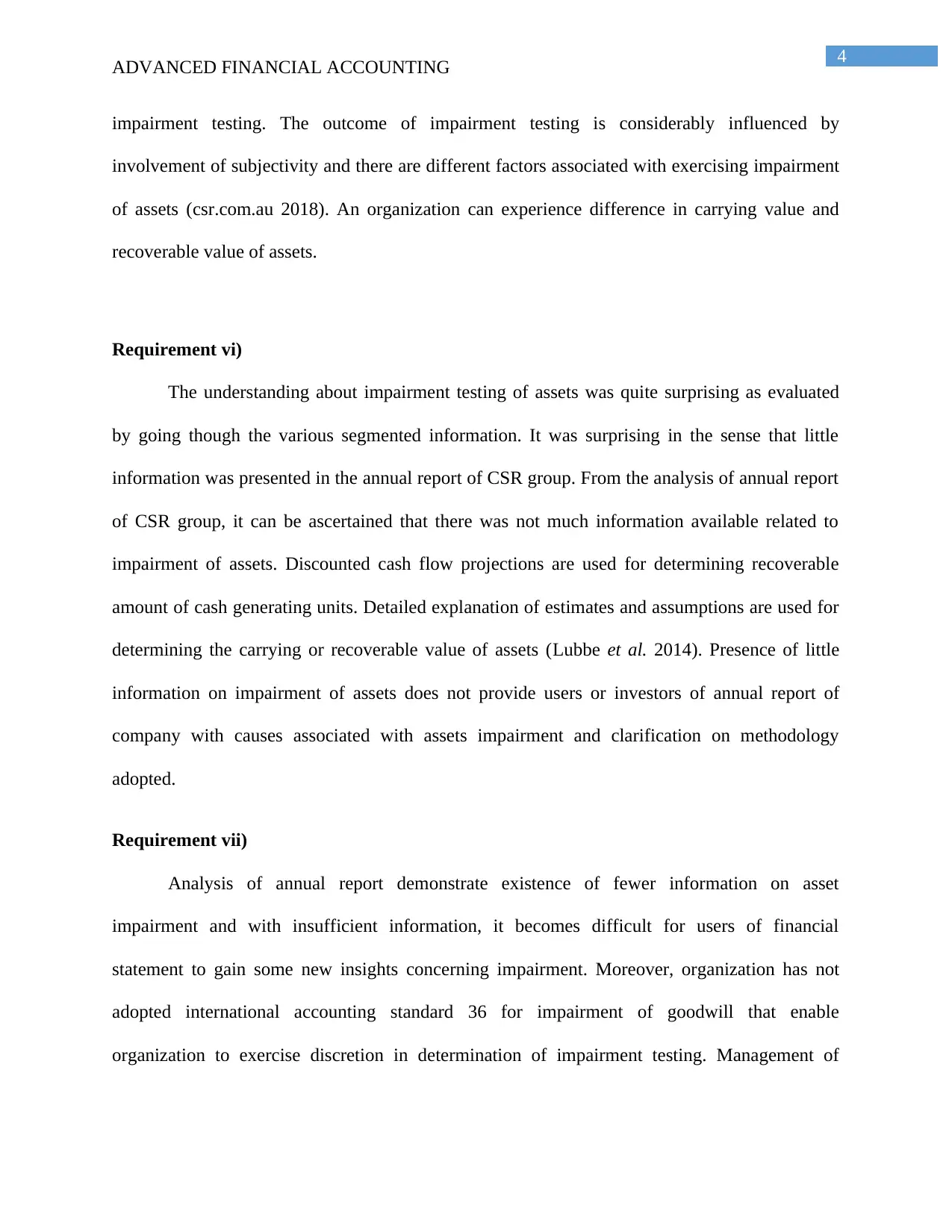
4
ADVANCED FINANCIAL ACCOUNTING
impairment testing. The outcome of impairment testing is considerably influenced by
involvement of subjectivity and there are different factors associated with exercising impairment
of assets (csr.com.au 2018). An organization can experience difference in carrying value and
recoverable value of assets.
Requirement vi)
The understanding about impairment testing of assets was quite surprising as evaluated
by going though the various segmented information. It was surprising in the sense that little
information was presented in the annual report of CSR group. From the analysis of annual report
of CSR group, it can be ascertained that there was not much information available related to
impairment of assets. Discounted cash flow projections are used for determining recoverable
amount of cash generating units. Detailed explanation of estimates and assumptions are used for
determining the carrying or recoverable value of assets (Lubbe et al. 2014). Presence of little
information on impairment of assets does not provide users or investors of annual report of
company with causes associated with assets impairment and clarification on methodology
adopted.
Requirement vii)
Analysis of annual report demonstrate existence of fewer information on asset
impairment and with insufficient information, it becomes difficult for users of financial
statement to gain some new insights concerning impairment. Moreover, organization has not
adopted international accounting standard 36 for impairment of goodwill that enable
organization to exercise discretion in determination of impairment testing. Management of
ADVANCED FINANCIAL ACCOUNTING
impairment testing. The outcome of impairment testing is considerably influenced by
involvement of subjectivity and there are different factors associated with exercising impairment
of assets (csr.com.au 2018). An organization can experience difference in carrying value and
recoverable value of assets.
Requirement vi)
The understanding about impairment testing of assets was quite surprising as evaluated
by going though the various segmented information. It was surprising in the sense that little
information was presented in the annual report of CSR group. From the analysis of annual report
of CSR group, it can be ascertained that there was not much information available related to
impairment of assets. Discounted cash flow projections are used for determining recoverable
amount of cash generating units. Detailed explanation of estimates and assumptions are used for
determining the carrying or recoverable value of assets (Lubbe et al. 2014). Presence of little
information on impairment of assets does not provide users or investors of annual report of
company with causes associated with assets impairment and clarification on methodology
adopted.
Requirement vii)
Analysis of annual report demonstrate existence of fewer information on asset
impairment and with insufficient information, it becomes difficult for users of financial
statement to gain some new insights concerning impairment. Moreover, organization has not
adopted international accounting standard 36 for impairment of goodwill that enable
organization to exercise discretion in determination of impairment testing. Management of
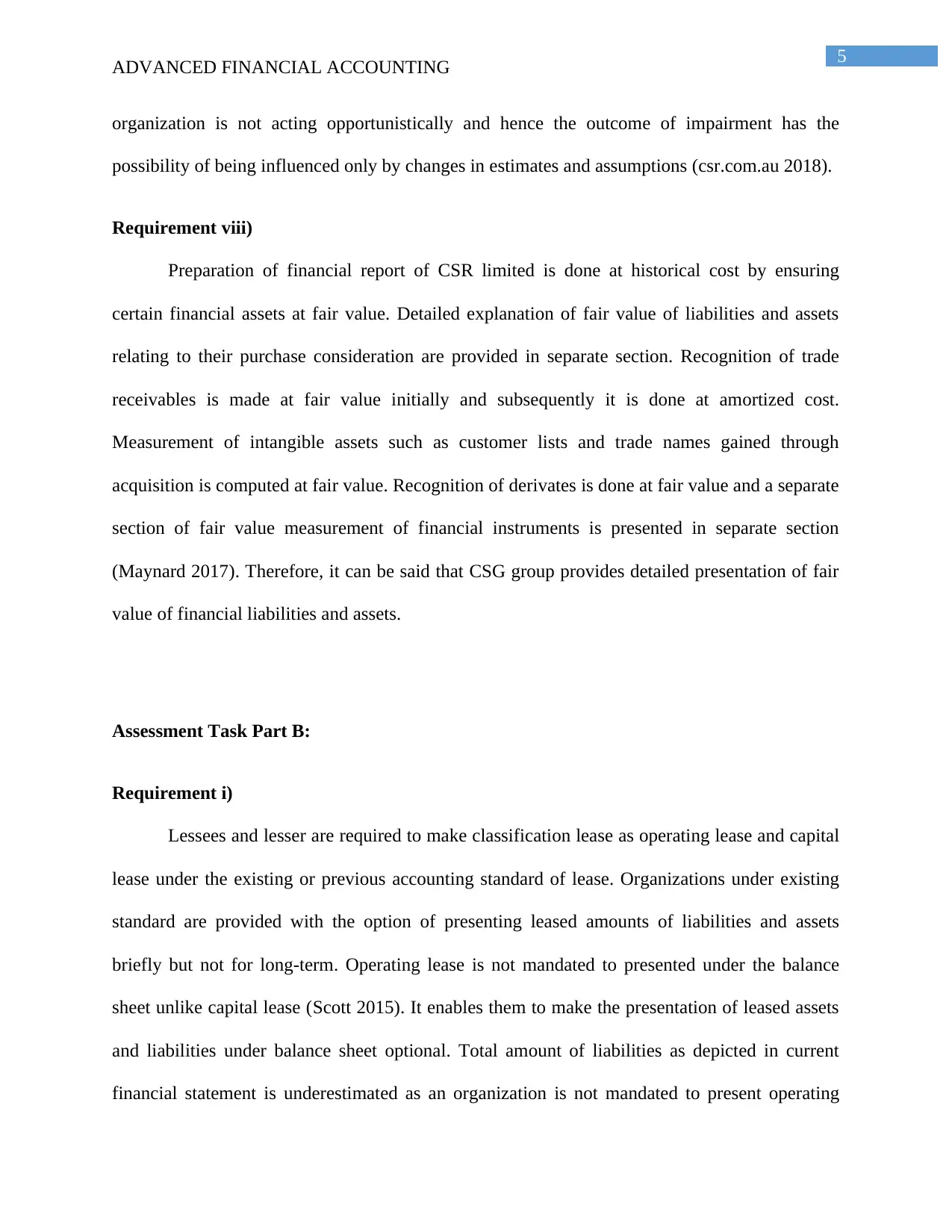
5
ADVANCED FINANCIAL ACCOUNTING
organization is not acting opportunistically and hence the outcome of impairment has the
possibility of being influenced only by changes in estimates and assumptions (csr.com.au 2018).
Requirement viii)
Preparation of financial report of CSR limited is done at historical cost by ensuring
certain financial assets at fair value. Detailed explanation of fair value of liabilities and assets
relating to their purchase consideration are provided in separate section. Recognition of trade
receivables is made at fair value initially and subsequently it is done at amortized cost.
Measurement of intangible assets such as customer lists and trade names gained through
acquisition is computed at fair value. Recognition of derivates is done at fair value and a separate
section of fair value measurement of financial instruments is presented in separate section
(Maynard 2017). Therefore, it can be said that CSG group provides detailed presentation of fair
value of financial liabilities and assets.
Assessment Task Part B:
Requirement i)
Lessees and lesser are required to make classification lease as operating lease and capital
lease under the existing or previous accounting standard of lease. Organizations under existing
standard are provided with the option of presenting leased amounts of liabilities and assets
briefly but not for long-term. Operating lease is not mandated to presented under the balance
sheet unlike capital lease (Scott 2015). It enables them to make the presentation of leased assets
and liabilities under balance sheet optional. Total amount of liabilities as depicted in current
financial statement is underestimated as an organization is not mandated to present operating
ADVANCED FINANCIAL ACCOUNTING
organization is not acting opportunistically and hence the outcome of impairment has the
possibility of being influenced only by changes in estimates and assumptions (csr.com.au 2018).
Requirement viii)
Preparation of financial report of CSR limited is done at historical cost by ensuring
certain financial assets at fair value. Detailed explanation of fair value of liabilities and assets
relating to their purchase consideration are provided in separate section. Recognition of trade
receivables is made at fair value initially and subsequently it is done at amortized cost.
Measurement of intangible assets such as customer lists and trade names gained through
acquisition is computed at fair value. Recognition of derivates is done at fair value and a separate
section of fair value measurement of financial instruments is presented in separate section
(Maynard 2017). Therefore, it can be said that CSG group provides detailed presentation of fair
value of financial liabilities and assets.
Assessment Task Part B:
Requirement i)
Lessees and lesser are required to make classification lease as operating lease and capital
lease under the existing or previous accounting standard of lease. Organizations under existing
standard are provided with the option of presenting leased amounts of liabilities and assets
briefly but not for long-term. Operating lease is not mandated to presented under the balance
sheet unlike capital lease (Scott 2015). It enables them to make the presentation of leased assets
and liabilities under balance sheet optional. Total amount of liabilities as depicted in current
financial statement is underestimated as an organization is not mandated to present operating
⊘ This is a preview!⊘
Do you want full access?
Subscribe today to unlock all pages.

Trusted by 1+ million students worldwide
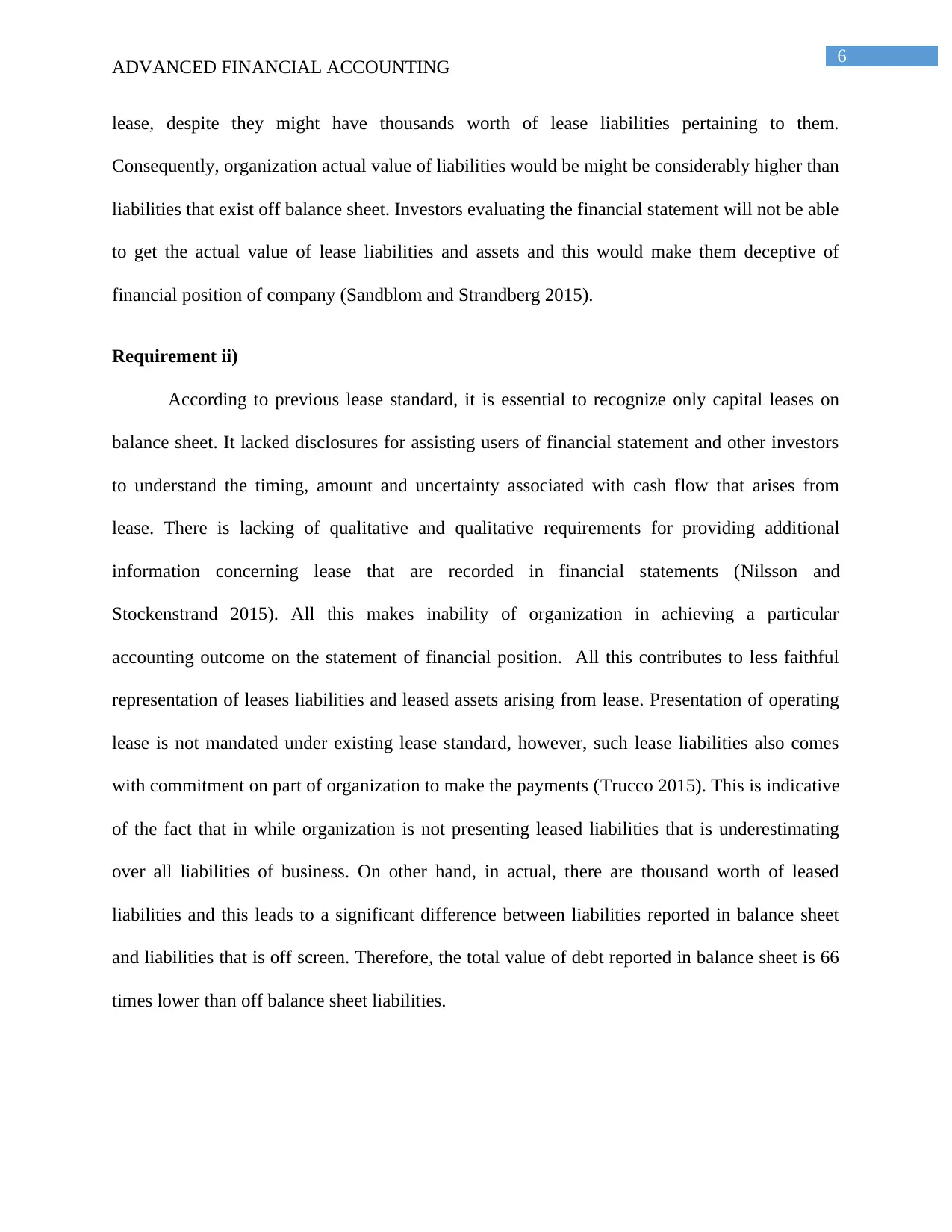
6
ADVANCED FINANCIAL ACCOUNTING
lease, despite they might have thousands worth of lease liabilities pertaining to them.
Consequently, organization actual value of liabilities would be might be considerably higher than
liabilities that exist off balance sheet. Investors evaluating the financial statement will not be able
to get the actual value of lease liabilities and assets and this would make them deceptive of
financial position of company (Sandblom and Strandberg 2015).
Requirement ii)
According to previous lease standard, it is essential to recognize only capital leases on
balance sheet. It lacked disclosures for assisting users of financial statement and other investors
to understand the timing, amount and uncertainty associated with cash flow that arises from
lease. There is lacking of qualitative and qualitative requirements for providing additional
information concerning lease that are recorded in financial statements (Nilsson and
Stockenstrand 2015). All this makes inability of organization in achieving a particular
accounting outcome on the statement of financial position. All this contributes to less faithful
representation of leases liabilities and leased assets arising from lease. Presentation of operating
lease is not mandated under existing lease standard, however, such lease liabilities also comes
with commitment on part of organization to make the payments (Trucco 2015). This is indicative
of the fact that in while organization is not presenting leased liabilities that is underestimating
over all liabilities of business. On other hand, in actual, there are thousand worth of leased
liabilities and this leads to a significant difference between liabilities reported in balance sheet
and liabilities that is off screen. Therefore, the total value of debt reported in balance sheet is 66
times lower than off balance sheet liabilities.
ADVANCED FINANCIAL ACCOUNTING
lease, despite they might have thousands worth of lease liabilities pertaining to them.
Consequently, organization actual value of liabilities would be might be considerably higher than
liabilities that exist off balance sheet. Investors evaluating the financial statement will not be able
to get the actual value of lease liabilities and assets and this would make them deceptive of
financial position of company (Sandblom and Strandberg 2015).
Requirement ii)
According to previous lease standard, it is essential to recognize only capital leases on
balance sheet. It lacked disclosures for assisting users of financial statement and other investors
to understand the timing, amount and uncertainty associated with cash flow that arises from
lease. There is lacking of qualitative and qualitative requirements for providing additional
information concerning lease that are recorded in financial statements (Nilsson and
Stockenstrand 2015). All this makes inability of organization in achieving a particular
accounting outcome on the statement of financial position. All this contributes to less faithful
representation of leases liabilities and leased assets arising from lease. Presentation of operating
lease is not mandated under existing lease standard, however, such lease liabilities also comes
with commitment on part of organization to make the payments (Trucco 2015). This is indicative
of the fact that in while organization is not presenting leased liabilities that is underestimating
over all liabilities of business. On other hand, in actual, there are thousand worth of leased
liabilities and this leads to a significant difference between liabilities reported in balance sheet
and liabilities that is off screen. Therefore, the total value of debt reported in balance sheet is 66
times lower than off balance sheet liabilities.
Paraphrase This Document
Need a fresh take? Get an instant paraphrase of this document with our AI Paraphraser
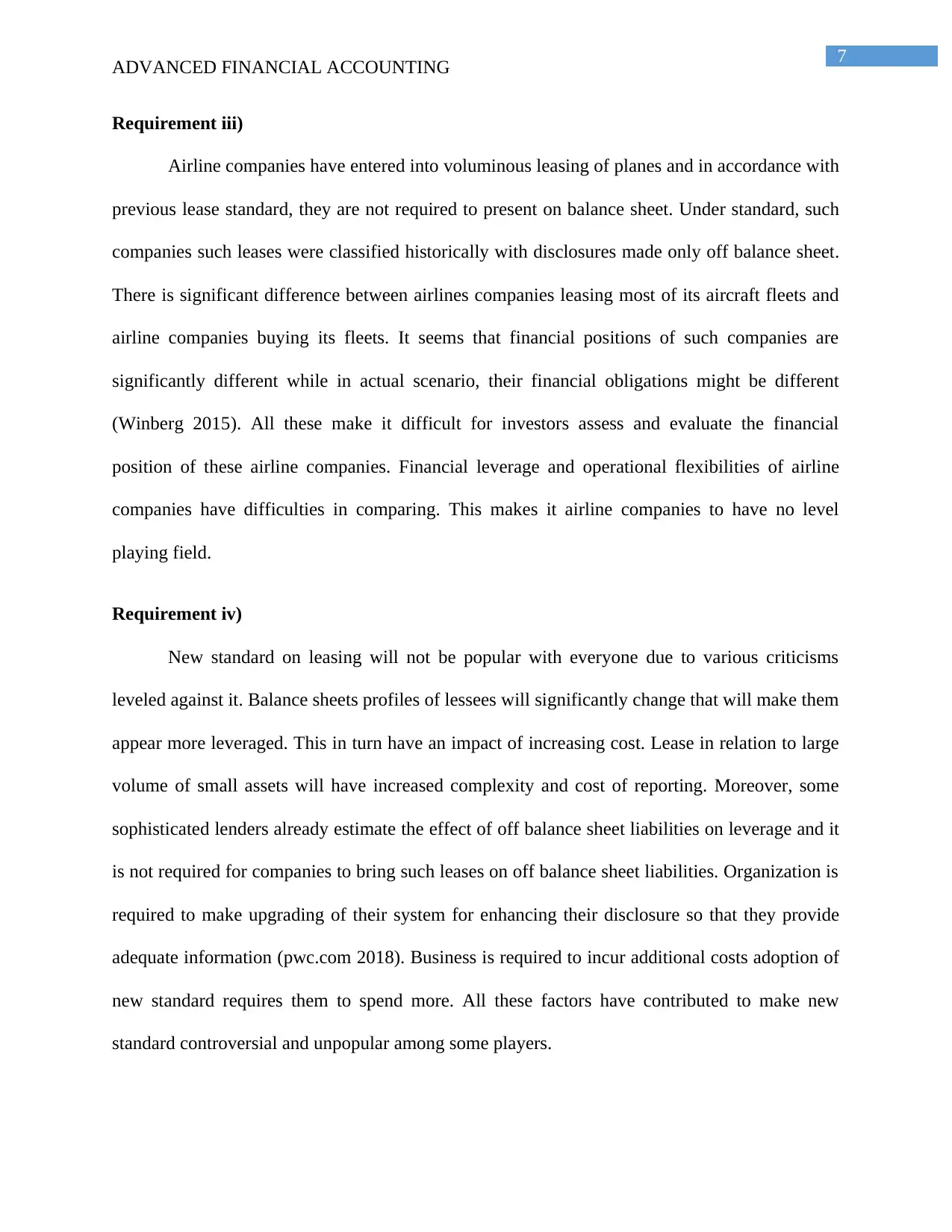
7
ADVANCED FINANCIAL ACCOUNTING
Requirement iii)
Airline companies have entered into voluminous leasing of planes and in accordance with
previous lease standard, they are not required to present on balance sheet. Under standard, such
companies such leases were classified historically with disclosures made only off balance sheet.
There is significant difference between airlines companies leasing most of its aircraft fleets and
airline companies buying its fleets. It seems that financial positions of such companies are
significantly different while in actual scenario, their financial obligations might be different
(Winberg 2015). All these make it difficult for investors assess and evaluate the financial
position of these airline companies. Financial leverage and operational flexibilities of airline
companies have difficulties in comparing. This makes it airline companies to have no level
playing field.
Requirement iv)
New standard on leasing will not be popular with everyone due to various criticisms
leveled against it. Balance sheets profiles of lessees will significantly change that will make them
appear more leveraged. This in turn have an impact of increasing cost. Lease in relation to large
volume of small assets will have increased complexity and cost of reporting. Moreover, some
sophisticated lenders already estimate the effect of off balance sheet liabilities on leverage and it
is not required for companies to bring such leases on off balance sheet liabilities. Organization is
required to make upgrading of their system for enhancing their disclosure so that they provide
adequate information (pwc.com 2018). Business is required to incur additional costs adoption of
new standard requires them to spend more. All these factors have contributed to make new
standard controversial and unpopular among some players.
ADVANCED FINANCIAL ACCOUNTING
Requirement iii)
Airline companies have entered into voluminous leasing of planes and in accordance with
previous lease standard, they are not required to present on balance sheet. Under standard, such
companies such leases were classified historically with disclosures made only off balance sheet.
There is significant difference between airlines companies leasing most of its aircraft fleets and
airline companies buying its fleets. It seems that financial positions of such companies are
significantly different while in actual scenario, their financial obligations might be different
(Winberg 2015). All these make it difficult for investors assess and evaluate the financial
position of these airline companies. Financial leverage and operational flexibilities of airline
companies have difficulties in comparing. This makes it airline companies to have no level
playing field.
Requirement iv)
New standard on leasing will not be popular with everyone due to various criticisms
leveled against it. Balance sheets profiles of lessees will significantly change that will make them
appear more leveraged. This in turn have an impact of increasing cost. Lease in relation to large
volume of small assets will have increased complexity and cost of reporting. Moreover, some
sophisticated lenders already estimate the effect of off balance sheet liabilities on leverage and it
is not required for companies to bring such leases on off balance sheet liabilities. Organization is
required to make upgrading of their system for enhancing their disclosure so that they provide
adequate information (pwc.com 2018). Business is required to incur additional costs adoption of
new standard requires them to spend more. All these factors have contributed to make new
standard controversial and unpopular among some players.
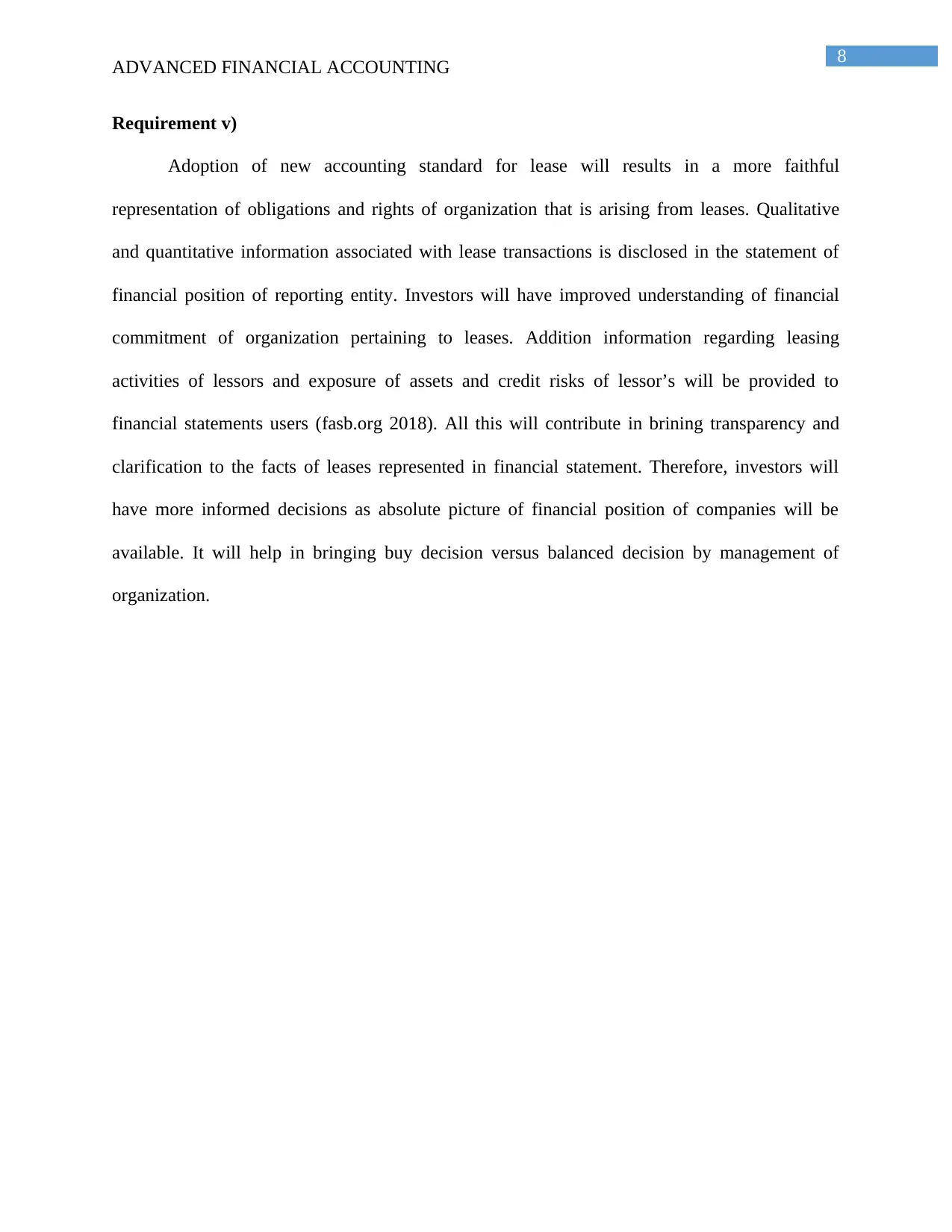
8
ADVANCED FINANCIAL ACCOUNTING
Requirement v)
Adoption of new accounting standard for lease will results in a more faithful
representation of obligations and rights of organization that is arising from leases. Qualitative
and quantitative information associated with lease transactions is disclosed in the statement of
financial position of reporting entity. Investors will have improved understanding of financial
commitment of organization pertaining to leases. Addition information regarding leasing
activities of lessors and exposure of assets and credit risks of lessor’s will be provided to
financial statements users (fasb.org 2018). All this will contribute in brining transparency and
clarification to the facts of leases represented in financial statement. Therefore, investors will
have more informed decisions as absolute picture of financial position of companies will be
available. It will help in bringing buy decision versus balanced decision by management of
organization.
ADVANCED FINANCIAL ACCOUNTING
Requirement v)
Adoption of new accounting standard for lease will results in a more faithful
representation of obligations and rights of organization that is arising from leases. Qualitative
and quantitative information associated with lease transactions is disclosed in the statement of
financial position of reporting entity. Investors will have improved understanding of financial
commitment of organization pertaining to leases. Addition information regarding leasing
activities of lessors and exposure of assets and credit risks of lessor’s will be provided to
financial statements users (fasb.org 2018). All this will contribute in brining transparency and
clarification to the facts of leases represented in financial statement. Therefore, investors will
have more informed decisions as absolute picture of financial position of companies will be
available. It will help in bringing buy decision versus balanced decision by management of
organization.
⊘ This is a preview!⊘
Do you want full access?
Subscribe today to unlock all pages.

Trusted by 1+ million students worldwide
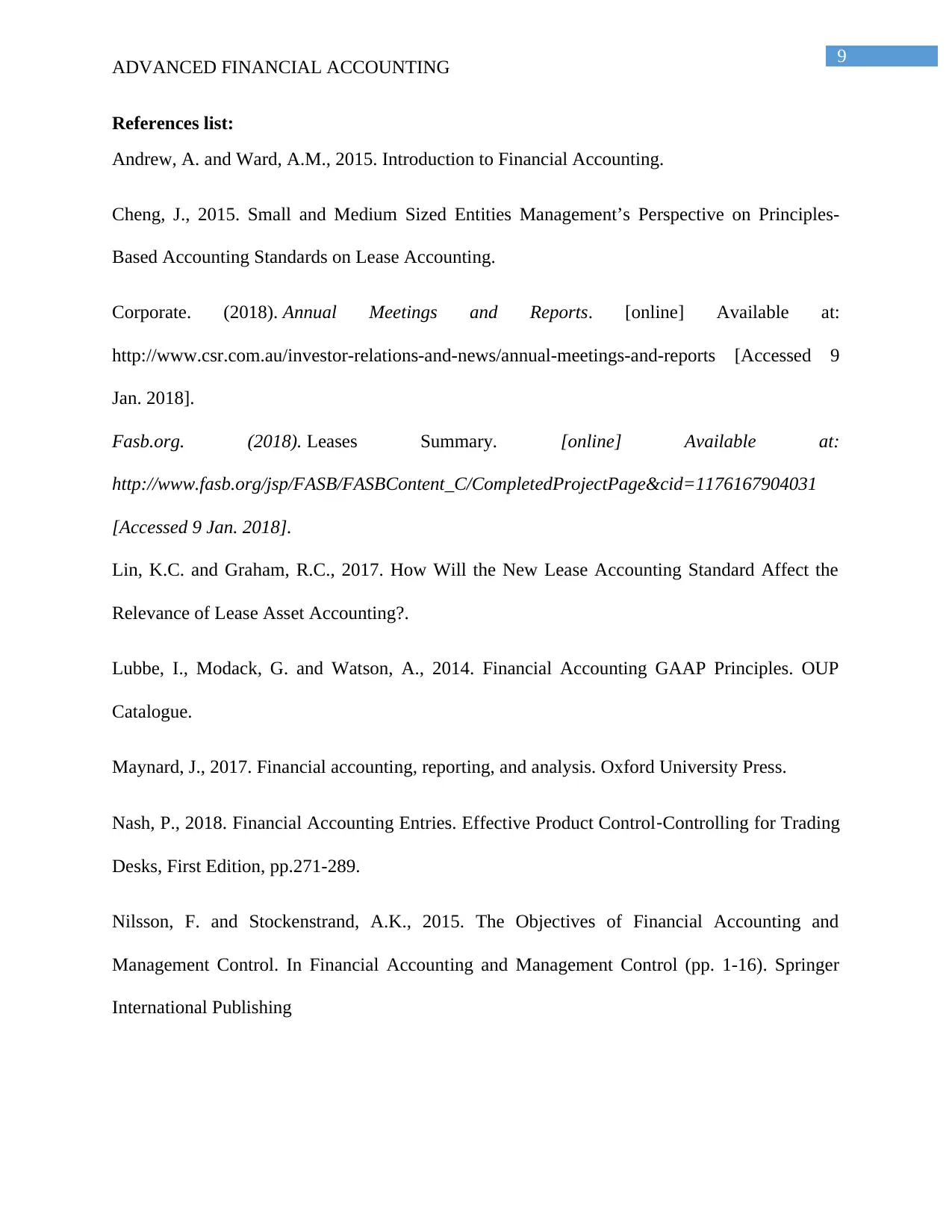
9
ADVANCED FINANCIAL ACCOUNTING
References list:
Andrew, A. and Ward, A.M., 2015. Introduction to Financial Accounting.
Cheng, J., 2015. Small and Medium Sized Entities Management’s Perspective on Principles-
Based Accounting Standards on Lease Accounting.
Corporate. (2018). Annual Meetings and Reports. [online] Available at:
http://www.csr.com.au/investor-relations-and-news/annual-meetings-and-reports [Accessed 9
Jan. 2018].
Fasb.org. (2018). Leases Summary. [online] Available at:
http://www.fasb.org/jsp/FASB/FASBContent_C/CompletedProjectPage&cid=1176167904031
[Accessed 9 Jan. 2018].
Lin, K.C. and Graham, R.C., 2017. How Will the New Lease Accounting Standard Affect the
Relevance of Lease Asset Accounting?.
Lubbe, I., Modack, G. and Watson, A., 2014. Financial Accounting GAAP Principles. OUP
Catalogue.
Maynard, J., 2017. Financial accounting, reporting, and analysis. Oxford University Press.
Nash, P., 2018. Financial Accounting Entries. Effective Product Control‐Controlling for Trading
Desks, First Edition, pp.271-289.
Nilsson, F. and Stockenstrand, A.K., 2015. The Objectives of Financial Accounting and
Management Control. In Financial Accounting and Management Control (pp. 1-16). Springer
International Publishing
ADVANCED FINANCIAL ACCOUNTING
References list:
Andrew, A. and Ward, A.M., 2015. Introduction to Financial Accounting.
Cheng, J., 2015. Small and Medium Sized Entities Management’s Perspective on Principles-
Based Accounting Standards on Lease Accounting.
Corporate. (2018). Annual Meetings and Reports. [online] Available at:
http://www.csr.com.au/investor-relations-and-news/annual-meetings-and-reports [Accessed 9
Jan. 2018].
Fasb.org. (2018). Leases Summary. [online] Available at:
http://www.fasb.org/jsp/FASB/FASBContent_C/CompletedProjectPage&cid=1176167904031
[Accessed 9 Jan. 2018].
Lin, K.C. and Graham, R.C., 2017. How Will the New Lease Accounting Standard Affect the
Relevance of Lease Asset Accounting?.
Lubbe, I., Modack, G. and Watson, A., 2014. Financial Accounting GAAP Principles. OUP
Catalogue.
Maynard, J., 2017. Financial accounting, reporting, and analysis. Oxford University Press.
Nash, P., 2018. Financial Accounting Entries. Effective Product Control‐Controlling for Trading
Desks, First Edition, pp.271-289.
Nilsson, F. and Stockenstrand, A.K., 2015. The Objectives of Financial Accounting and
Management Control. In Financial Accounting and Management Control (pp. 1-16). Springer
International Publishing
Paraphrase This Document
Need a fresh take? Get an instant paraphrase of this document with our AI Paraphraser
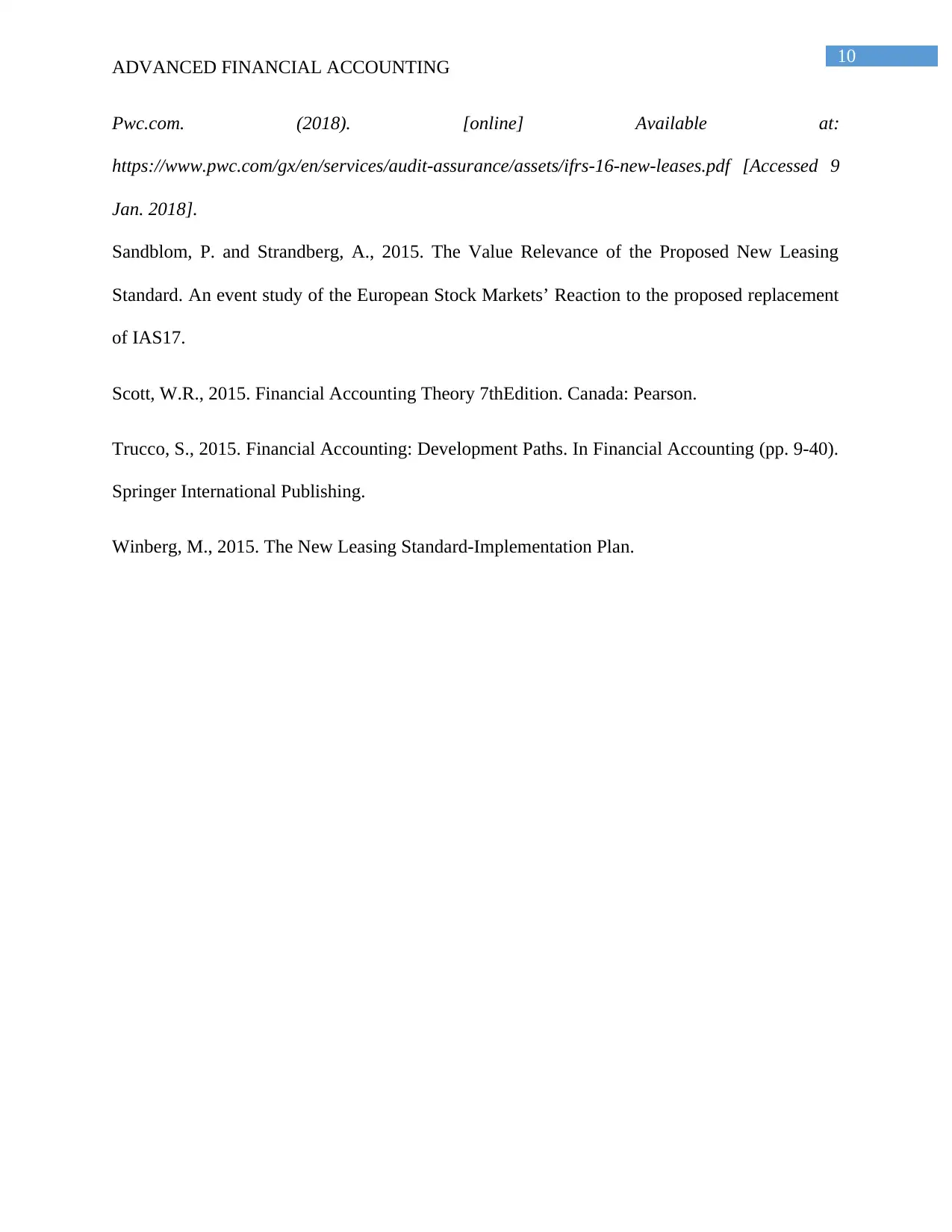
10
ADVANCED FINANCIAL ACCOUNTING
Pwc.com. (2018). [online] Available at:
https://www.pwc.com/gx/en/services/audit-assurance/assets/ifrs-16-new-leases.pdf [Accessed 9
Jan. 2018].
Sandblom, P. and Strandberg, A., 2015. The Value Relevance of the Proposed New Leasing
Standard. An event study of the European Stock Markets’ Reaction to the proposed replacement
of IAS17.
Scott, W.R., 2015. Financial Accounting Theory 7thEdition. Canada: Pearson.
Trucco, S., 2015. Financial Accounting: Development Paths. In Financial Accounting (pp. 9-40).
Springer International Publishing.
Winberg, M., 2015. The New Leasing Standard-Implementation Plan.
ADVANCED FINANCIAL ACCOUNTING
Pwc.com. (2018). [online] Available at:
https://www.pwc.com/gx/en/services/audit-assurance/assets/ifrs-16-new-leases.pdf [Accessed 9
Jan. 2018].
Sandblom, P. and Strandberg, A., 2015. The Value Relevance of the Proposed New Leasing
Standard. An event study of the European Stock Markets’ Reaction to the proposed replacement
of IAS17.
Scott, W.R., 2015. Financial Accounting Theory 7thEdition. Canada: Pearson.
Trucco, S., 2015. Financial Accounting: Development Paths. In Financial Accounting (pp. 9-40).
Springer International Publishing.
Winberg, M., 2015. The New Leasing Standard-Implementation Plan.
1 out of 11
Related Documents
Your All-in-One AI-Powered Toolkit for Academic Success.
+13062052269
info@desklib.com
Available 24*7 on WhatsApp / Email
![[object Object]](/_next/static/media/star-bottom.7253800d.svg)
Unlock your academic potential
Copyright © 2020–2025 A2Z Services. All Rights Reserved. Developed and managed by ZUCOL.





